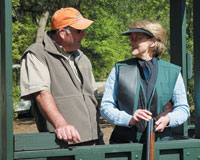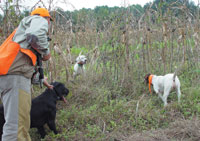 Nothing guarantees a
miss more than taking one’s eyes off the bird before the
shot is completed – usually “fluffing” the
shot. The experienced Gun keeps his muzzles on line, with his
eyes out to the closing covey. Leading with the left hand and
coordinating a simple step with the left leg into the line of
flight, the muzzles mimic the speed and flight line throughout
the mount. The shot is taken as the mount is completed and the
stock hits the shoulder. Nothing guarantees a
miss more than taking one’s eyes off the bird before the
shot is completed – usually “fluffing” the
shot. The experienced Gun keeps his muzzles on line, with his
eyes out to the closing covey. Leading with the left hand and
coordinating a simple step with the left leg into the line of
flight, the muzzles mimic the speed and flight line throughout
the mount. The shot is taken as the mount is completed and the
stock hits the shoulder.
If the mount is good and the gun fit accurate, the barrels will point where you
are looking, as you push out in front of the bird and pull the trigger. Be sure
to see the bird fall. If it is wounded, do not hesitate to give it the second
barrel. That is what it is there for - to see off the crippled quarry. Only after
you witness the crumple and fall of the first bird, should you look for a second
bird. Once again, align the muzzles and your eye with the bird before repeating “the
step”, reaching to it with arm and leg in unison.
With regard to this “stepping into the line”, it should not be a
stride forward, but rather a small step. Try to imagine you are standing within
the circumference of a trash can lid and must keep within its perimeters. Heels
no more than 6 or 7 inches apart and weight firmly on the front foot, be confident
- lock onto your bird well out in front, make a smooth move to it and through
it, coordinating eye, hand and feet to bring the bird down with a clean kill.
The Stanbury technique of maintaining the weight firmly on the front foot always
works well on the Classic Presentations.
|
 I
have a different technique for those “High Flyers” launched
from hills and steep banks. With these High Birds, what works on
the low, fast-driven “Hedgehoppers” will not cut the
mustard. You need to shoot them more in the manner of High Pheasant. I
have a different technique for those “High Flyers” launched
from hills and steep banks. With these High Birds, what works on
the low, fast-driven “Hedgehoppers” will not cut the
mustard. You need to shoot them more in the manner of High Pheasant.
This technique still requires the ascertainment of speed and line of flight,
with eye and muzzle combining with gun mount and footwork to keep a square, level
swing throughout the shot.
Where the technique on High Driven Partridge differs from the Stanbury technique
used in the low, driven approach, is in the weight distribution between the feet.
With the Tall Partridge, I favour the Churchill Method, and transfer the weight
to the back foot during the shot. This allows the gun to be kept on line much
more accurately and also allows better control of the gun, a necessity with any
bird above 35 yards.

|
  Determining
the line of flight and being able to maintain the muzzles on it,
is much more important with High Partridge than any considerations
of lead. The optimum place to take the shot is when the bird is
at about 80 degrees, just before the perpendicular. If you are
not on line, you will miss. Consistently holding the line will
get you hitting the long shots more regularly.
Early season Partridge shooting is a real pleasure - the last of the summer weather
and longer evenings leave time for more drives, without the constraints and pressure
placed on the Gun by the later season’s shortening daylight. The great
thing about shooting Partridge in Spain is, not only is their season longer,
but the weather warmer and the daylight also longer. These seasonal advantages,
combined with the hospitable people, the wonderful food and the great wine, make
Spain just about perfect for Partridge. I hope that you will join me one season
to sample what is, without a doubt, some of the very best wing shooting in the
world.
With regard to the choice of gun, choke and cartridges, I prefer a 20 bore, but
any gauge is acceptable. If it is your intention to shoot a large bag, you will
need a pair of guns. If a moderate bag or a small day is your preference, a single
gun is fine. As to choke, I like modified in both barrels. I would use a 1 ounce
load if shooting an Over and Under, and 7/8 ounce if shooting a Side by Side. |
This
October begins our series of One Day Clays and Quail Wing Shooting
Schools, designed especially for The Upland Hunter.

We
start the day with a classroom session, then test your skills
on The Sporting Clays course. After lunch, it’s a traditional
Georgia Quail Hunt in the beautiful natural woodlands of The
Lowcountry.
Skilled guides, exceptional hunting dogs and fast,
hard-flying bobwhite quail make a sporting challenge for even the best shot!
The Dorchester Shooting Preserve’s 4000
acres of private hunting grounds are located 25 minutes south of Savannah,
Georgia. Non-shooting companions
can tour the Historic District during the day, then join you after the school
for a gourmet dinner at any one of Savannah’s well-known restaurants.
|
One Day Clays And Quail
Wing Shooting Schools
January 6 • February 17
The schools are limited to 4 students
and the cost of $750.00 includes all instruction, videotaping,
clays, on-site transportation,
guides, hunting dogs and
8 quail.

|

Additional quail are $10.00 each. Prepared quail
may be taken home
at no extra charge. Ammunition is not included, but may be purchased
on-site at the members’ cost.
Gunfittings and Hourly Lessons
January 7 & 8 • February 18 & 19
A gunfitting takes about 2 hours and the cost
is $350.00. 4 slots are available per day. Hourly lessons are $160.00
per hour for
one person, $235.00 per hour
for two people.
Page 3
|

 Determining
the line of flight and being able to maintain the muzzles on it,
is much more important with High Partridge than any considerations
of lead. The optimum place to take the shot is when the bird is
at about 80 degrees, just before the perpendicular. If you are
not on line, you will miss. Consistently holding the line will
get you hitting the long shots more regularly.
Determining
the line of flight and being able to maintain the muzzles on it,
is much more important with High Partridge than any considerations
of lead. The optimum place to take the shot is when the bird is
at about 80 degrees, just before the perpendicular. If you are
not on line, you will miss. Consistently holding the line will
get you hitting the long shots more regularly.


